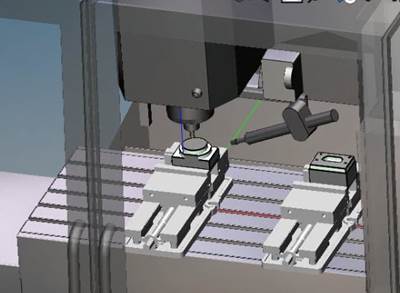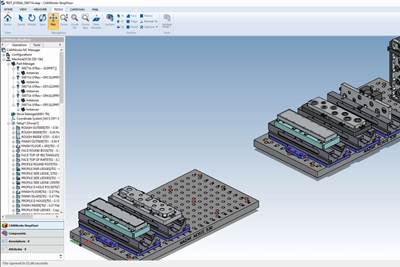Share





Collision detection features in SolidWorks save Speedway Motors a lot of time and scrap during prototyping, as the software can automatically detect when tooling and fixture interfere with each other. This is especially useful for its shock work parts with tight tolerances. All images courtesy of HCL Technologies.
In 2009, Speedway Motors of Lincoln, Nebraska, had only two CNC machines to machine its aftermarket car parts. Today, it has 19, with tens of thousands of part numbers on offer. Creating the parts and part programs that have fueled this growth has required software which the shop can quickly train new operators to use and which streamlines the transition from model to program to completed part. The company has found HCL’s CAMWorks and Dassault Systemes’ SolidWorks to be valuable for both tasks. Training programs from Speedway Motors’ CAMWorks reseller swiftly upskilled experienced and green operators alike, while onboard features have cut both programming time and part cycle times.
From New Hire to Five-Axis Machinist
Speedway Motors employs three-axis vertical and horizontal mills, five-axis mills and turn-mills, and has expanded its shop personnel to the same degree as its machines. In 2009, it only employed two people in the machine shop. In 2016, there were 12 people in the shop between machining and fabrication. By mid-2024, this number had climbed to 50 people — 30 of whom are in the machining department.
Ensuring that the shop’s staff has the skills they need to use the machines to their full effect has been vital to maintaining this growth. Equally important is the need to make sure the shop can program new parts quickly. Hawk Ridge Systems, Speedway Motors’ CAMWorks reseller, connected the shop with SolidProfessor, a training program that specializes in SolidWorks CAD software and compatible CAM systems, including CAMWorks.
Speedway Motors CNC Mill Team Lead Landon Rayburn says this program is particularly helpful due to bite-sized lessons machinists can fit into small gaps of downtime during the day. He also highlights the way it promotes active learning, guiding users to interact with a demonstration version of the SolidWorks and CAMWorks software rather than only watching a video.
The company’s CNC Department Supervisor, Lucas Prucha, points to one of its newer hires as an example of the program’s effectiveness. One year after hiring a new employee fresh out of community college, the machinist is now able to run five-axis parts.

Training resources for CAMWorks and SolidWorks have further solidified these software packages’ place in Speedway Motors’ machine shop. Prucha credits SolidProfessor with the rapid upskilling of an employee Speedway Motors hired fresh from community college. Less than a year after his hiring, he was programming five-axis parts.
Simplifying Machining Behind the Scenes
Just as the training program is a major boon to Speedway Motors, the onboard software has also proved valuable to the job shop as it tackles its wide range of jobs. In particular, the shop has made heavy use of the CAMWorks Technology Database (which HCL Software often shortens to TechDB) and VoluMill.
TechDB is a user-specific database that comes preloaded with some information about speeds, feeds and depths of cut for different tools, but which ultimately gains strength as it accumulates data from years of saved part programs. It “is kind of like the behind the scenes, controlling your machining strategies,” Prucha says.
When the shop needs to add a feature to a program in progress, TechDB can suggest the most effective tool for the job based on past jobs’ performances, along with suggesting speeds, feeds and other strategies for different types of machining passes (that is, roughing versus finishing or chamfering). “If you did everything individually every single time, it would take you 10 minutes. But you can click generate and then it just pops it in, takes a couple of mouse clicks,” Prucha says. Saving time isn’t the only benefit of relying on this data, however, as it also improves the shop’s consistency by standardizing best practices. In the near future, Prucha and his team plan to take this further with a data refinement project, adding and standardizing the information in the database.
Speedway Motors constantly has new parts moving through the machine shop, so TechDB is continually useful. That said, with as much milling as the shop performs, VoluMill is equally useful in preparing part programs.
This feature within CAMWorks optimizes metal removal rates according to internal algorithms, often drastically shortening part cycle times and programming times. While the shop doesn’t have full benchmarks on how much time this feature saves (it has been using VoluMill as part of its standard practices ever since adopting CAMWorks in 2009), the software does include estimates of what the equivalent cycle time would be for a traditionally programmed part. With one part, this is a difference of 12.048 minutes to 1.992 minutes for each workpiece.

A copy/paste feature in the SolidWorks and CAMWorks ecosystem enables programmers to take a proven feature and duplicate it elsewhere in the part, saving time and standardizing processes.
The Perks of Integrated Software
Beyond the workings of VoluMill and TechDB, the structure of CAMWorks and SolidWords saves time for Speedway Motors’ programmers. Namely, these programs are integrated, looping into each other to the degree that Rayburn says “It doesn’t even seem like they’re two pieces of software. They’re so well integrated that SolidWorks and CAMWorks are one and the same for us.”
The Speedway Motors team can open an engineer’s SolidWorks model in CAMWorks and figure out the bounding box, material and tooling through a few simple test tool paths, and collision detection in SolidWorks ensures that tooling and fixtures do not interfere with each other. Alterations to a part in SolidWorks also transfer over to CAMWorks with a single prompt, which regenerates the program to match the updated model.
The speed of part creation that CAMWorks and SolidWorks enable, especially when paired with the training resources Speedway Motors has to hand, has helped the shop thrive in a post-COVID world as more suppliers have searched for U.S.-based supply chains. The company has been able to open new distribution centers and purchase new locations to continue its growth, all while relying on the swift, steady part production of its flagship headquarters and machine shop.
Related Content
The Intersection of Work, Play, Technology and Independence
The February issue dives into digital technologies that not only streamline production, but make a tangible difference in people’s lives.
Read MoreCan ChatGPT Create Usable G-Code Programs?
Since its debut in late 2022, ChatGPT has been used in many situations, from writing stories to writing code, including G-code. But is it useful to shops? We asked a CAM expert for his thoughts.
Read MoreThe Power of Practical Demonstrations and Projects
Practical work has served Bridgerland Technical College both in preparing its current students for manufacturing jobs and in appealing to new generations of potential machinists.
Read MoreAdvanced CAMs Simplify Programming of Conical Barrel Cutters
Conical barrel cutters have grown in popularity thanks to the large stepovers that reduce the time needed for some finishing processes, but advanced CAM systems can dramatically improve their usefulness.
Read MoreRead Next
How Integrated CAD/CAM Transforms Inventions Into Products
The close connection between CAD and CAM is what links creative ideas to practical production for this unique custom manufacturer.
Read MoreIntegrated CAM Software Automates Data Transition From Engineering to Production
By switching to CAMWorks software, Decimal Engineering was able to boost its throughput and quality while saving time and money.
Read MoreBringing Machining In-House to Keep up With Demand for Offroading Parts
To meet demand increases for its Ford offroad industry components, supplier RPG Offroad brought its machining processes in-house, saving the company nearly $50,000 per month. Here’s how its choice of integrated CAD/CAM software made it happen.
Read More
































